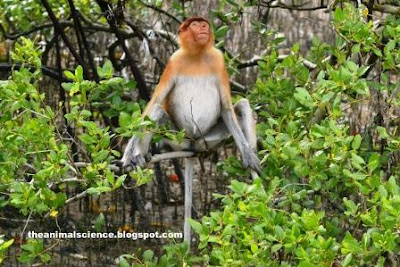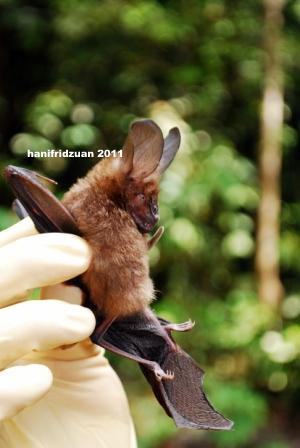Scientific name: Nasalis larvatus
Common name: Proboscis monkey/ Monyet Belanda (Malay)
 |
| A female proboscis monkey sitting on the tree branch. Photo by: Hanifridzuan |
 |
| A female proboscis monkey. Photo by: Hanifridzuan |
Proboscis monkey is endemic to Borneo. This endangered species show a high degree of sexual dimorphism. The body size of the males is usually larger than the females. The males also have a large protruding nose and this characteristic could distinguish between the males and the females of Proboscis monkey. This species lives in a group (called as harem) of 10 to 30 individuals comprises of one adults male and several females (with their young).
In Sarawak, Malaysia, this species can be found in Bako National Park (one of the smallest and the oldest national park in Malaysia, gazetted as protected area on 1957). There are seven types of forest in Bako National Park (beach, cliff, kerangas, mangrove, mixed dipterocarp, grassland and peat swamp).
What is the conservation status of Proboscis monkey? It is listed as endangered species in IUCN 2010 and listed in CITES Apendix I. Source: Meijaard, E., Nijman, V. & Supriatna, J. 2008. Nasalis larvatus. In: IUCN 2010. IUCN Red List of Threatened Species. Version 2010.4. <www.iucnredlist.org>. Downloaded on 02 May 2011.
 |
| Male Proboscis monkey with a large protruding nose. Photo by: Isham Azhar |
 |
| Random view at Bako National Park. Photo by: Isham Azhar |
Other species of large mammals that can be easily encountered in Bako National Park are silver leaf monkeys, long tailed macaques and bearded pigs (the largest mammal in Bako National Park).
 |
A female silver leaf monkey with the adorable baby clinging to its body.
Photo by: Hanifridzuan. |
The infant of a silver leaf monkey (
Trachypithecus cristatus) are bright orange in colours and will last for a few months before it change to silvery grey colours. This species is listed as near threatened by the IUCN and the population trend of this species is decreasing. Source: Nijman, V. & Meijaard, E. 2008.
Trachypithecus cristatus. In: IUCN 2010. IUCN Red List of Threatened Species. Version 2010.4. <
www.iucnredlist.org>. Downloaded on
02 May 2011.
 |
| The naughty long tailed macaque. Photo by: Hanifridzuan |
 |
| Bearded pig, the largest mammal in Bako National Park. Photo by: Hanifridzuan |
Bearded pig (
Sus barbatus) listed as vulnerable in the IUCN and the population trend of this species is also decreasing. Source: Kawanishi, K., Gumal, M. & Oliver, W. 2008.
Sus barbatus. In: IUCN 2010. IUCN Red List of Threatened Species. Version 2010.4. <
www.iucnredlist.org>. Downloaded on
02 May 2011. In Bako National Park, visitors can easily found this unique animals walking around the park HQ.


















